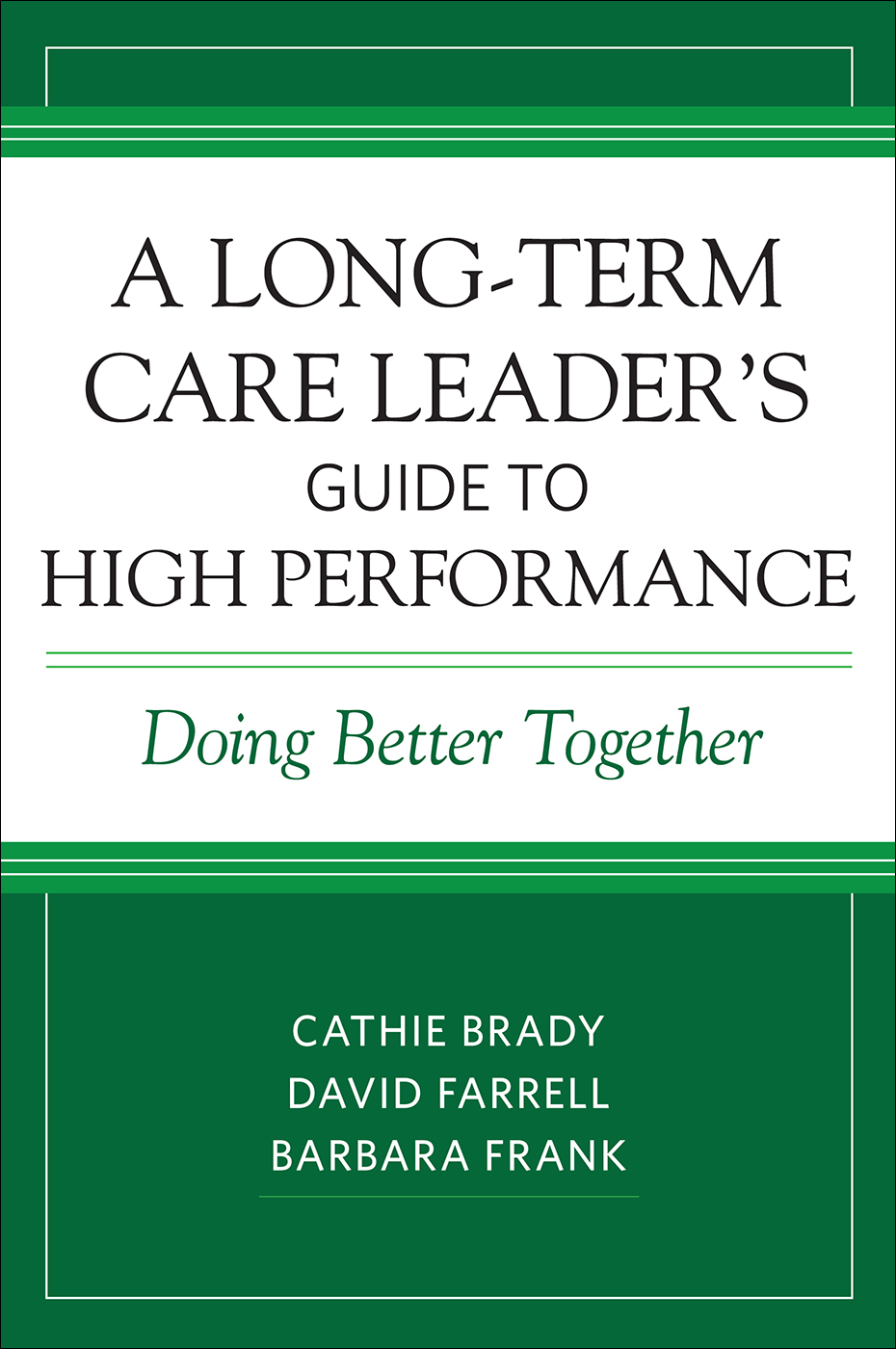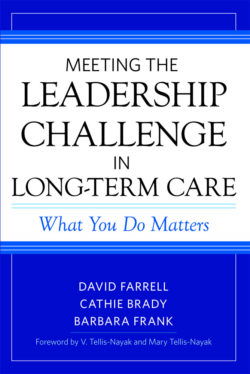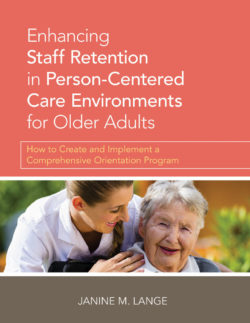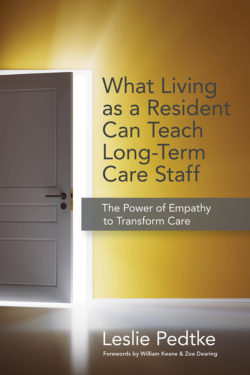Product Description
From the authors of the award-winning Meeting the Leadership Challenge in Long-Term Care, this book provides a blueprint for success in today’s performance-based healthcare system. It presents a tested approach to delivering optimal care to each resident using a proven, coordinated bundle of key practices that include:
- Leadership that brings out the best in staff
- A communication infrastructure to support teamwork throughout an organization
- A high-involvement performance improvement process that delivers quality person-centered care and prevents avoidable declines
This practical resource takes long-term care leaders through the critical steps to achieve staff stability, strengthen coordination of care, and maintain the highest practicable well-being for each resident. It demonstrates how engaging staff in continuous quality improvement produces consistently high-quality care.
Whether care communities are excelling or struggling, leaders can benefit from these performance-improving practices. Filled with candid, impactful personal accounts about implementing quality improvement in nursing homes, A Long-Term Care Leader’s Guide reveals precisely how leaders and their staff can do better, together.
Accompanying downloadable, how-to guides include:
- Three Steps to Transforming the Medication Pass: Individualizing Care and Managing Workflow
- Rethinking the Use of Position-Change Alarms
- Eliminating Off-Label Use of Antipsychotics: A 10-Step Guide for Nursing Homes
- MUSIC & MEMORY℠: Implementation Steps to Maximize Benefits: A Nursing Home Leader’s Guide
- Communication Infrastructure Self-Assessment
Format: E-book
e-ISBN 978-1-938870-77-4
E-book available through:
Also available through: Bowker, Baker and Taylor, OverDrive, Gardners, and Follett
Downloadable Resources
About the Authors
Acknowledgments
Foreword, X Marks the Spot: The Evidence, by Amy E. Elliot, Ph.D.
Foreword, by Jody Hoffer Gittell, Ph.D.
A Note to Our Readers: In It Together
Introduction
Shock and Awe, by David J. Farrell
PART I: People
- High-Performance Leadership: The Business Mandate
- Staff Stability: Why and How
- High-Involvement Leadership: Why and How
PART II: Systems
- Relationships Closest to the Resident Matter Most
- Quality Improvement Closest to the Resident
- Care Planning for the Highest Practicable Well-Being
PART III: Processes
- Doing Better Together
- A Doing Better Together Story: Finger Foods
Index
 Cathie Brady, M.S., has more than thirty years’ experience providing services and advocating for the elderly in a variety of settings, including serving as Executive Director of the Department of Aging Services for the city of Bristol, Connecticut, and for 10 years as the Regional LTC Ombudsman for Eastern Connecticut. Cathie has an M.S. in Organizational Management from Eastern Connecticut State University. She is co-founder (with her co-author Barbara Frank) of B&F Consulting, where she co-produced a Webcast for the Center for Medicare and Medicaid Services on “The How of Change: ‘What a difference management makes!’” Cathie directed the Connecticut Career Ladder and Culture Change Initiative. For 3 years, she worked with the New Orleans Nursing Home Staffing Project, which helped nursing homes recover from the aftermath of Hurricane Katrina. She co-produced a film with Louisiana Public Broadcasting called The Big Uneasy: Katrina’s Unsung Heroes. Cathie is a frequent speaker at state and national conferences and specializes in leadership development at all levels of an organization to assist nursing homes interested in being better places to live and work.
Cathie Brady, M.S., has more than thirty years’ experience providing services and advocating for the elderly in a variety of settings, including serving as Executive Director of the Department of Aging Services for the city of Bristol, Connecticut, and for 10 years as the Regional LTC Ombudsman for Eastern Connecticut. Cathie has an M.S. in Organizational Management from Eastern Connecticut State University. She is co-founder (with her co-author Barbara Frank) of B&F Consulting, where she co-produced a Webcast for the Center for Medicare and Medicaid Services on “The How of Change: ‘What a difference management makes!’” Cathie directed the Connecticut Career Ladder and Culture Change Initiative. For 3 years, she worked with the New Orleans Nursing Home Staffing Project, which helped nursing homes recover from the aftermath of Hurricane Katrina. She co-produced a film with Louisiana Public Broadcasting called The Big Uneasy: Katrina’s Unsung Heroes. Cathie is a frequent speaker at state and national conferences and specializes in leadership development at all levels of an organization to assist nursing homes interested in being better places to live and work.
 David Farrell, M.S.W., L.N.H.A., is a licensed nursing home administrator who has spent over 30 years in the healthcare profession. He started as a certified nursing assistant in order to earn extra money while attending college. That experience inspired him to pursue a Master’s degree in Social Work with a concentration in gerontology and administration from Boston College. Throughout his career in various leadership positions, David has advocated for patient-centered care using quality improvement practices. A nationally recognized leader in the field, he has traveled the country to deliver inspiring presentations to health care executives at conferences and training events. Currently, David is the Vice President of Subacute Services at Telecare Corporation located in Alameda, California.
David Farrell, M.S.W., L.N.H.A., is a licensed nursing home administrator who has spent over 30 years in the healthcare profession. He started as a certified nursing assistant in order to earn extra money while attending college. That experience inspired him to pursue a Master’s degree in Social Work with a concentration in gerontology and administration from Boston College. Throughout his career in various leadership positions, David has advocated for patient-centered care using quality improvement practices. A nationally recognized leader in the field, he has traveled the country to deliver inspiring presentations to health care executives at conferences and training events. Currently, David is the Vice President of Subacute Services at Telecare Corporation located in Alameda, California.
 Barbara Frank, M.P.A., began her career in long-term care by serving 16 years at the National Citizens’ Coalition for Nursing Home Reform in Washington, D.C., where she facilitated the Campaign for Quality, through which providers, consumers, practitioners, and regulators developed consensus on what became the OBRA 1987 legislation that overhauled nursing home regulations to require more individualized care. She has served as state ombudsman for Connecticut. Barbara facilitated the first Pioneer Network gathering in 1997, and in 2005, she facilitated the St. Louis Accord, a national gathering of providers, consumers, regulators, and quality improvement organizations that came together to improve clinical outcomes through culture change. Co-founder (with her colleague, Cathie Brady) of B&F Consulting, she works directly with individual nursing homes to improve their performance measures through workforce retention and culture change. Barbara led a team in the New Orleans Nursing Home Staffing Project, which helped nursing homes recover from the aftermath of Hurricane Katrina. She co-produced a film with Louisiana Public Broadcasting called The Big Uneasy: Katrina’s Unsung Heroes. She co-authored Nursing Homes: Getting Good Care There (1996) and has written extensively on efforts to improve care and outcomes in nursing homes. Barbara has an M.P.A. from the Kennedy School of Government.
Barbara Frank, M.P.A., began her career in long-term care by serving 16 years at the National Citizens’ Coalition for Nursing Home Reform in Washington, D.C., where she facilitated the Campaign for Quality, through which providers, consumers, practitioners, and regulators developed consensus on what became the OBRA 1987 legislation that overhauled nursing home regulations to require more individualized care. She has served as state ombudsman for Connecticut. Barbara facilitated the first Pioneer Network gathering in 1997, and in 2005, she facilitated the St. Louis Accord, a national gathering of providers, consumers, regulators, and quality improvement organizations that came together to improve clinical outcomes through culture change. Co-founder (with her colleague, Cathie Brady) of B&F Consulting, she works directly with individual nursing homes to improve their performance measures through workforce retention and culture change. Barbara led a team in the New Orleans Nursing Home Staffing Project, which helped nursing homes recover from the aftermath of Hurricane Katrina. She co-produced a film with Louisiana Public Broadcasting called The Big Uneasy: Katrina’s Unsung Heroes. She co-authored Nursing Homes: Getting Good Care There (1996) and has written extensively on efforts to improve care and outcomes in nursing homes. Barbara has an M.P.A. from the Kennedy School of Government.
Putting into Action Doing Better Together: Four How-Tos and a Self-Assessment
A Long-Term Care Leader’s Guide to High Performance comes with this downloadable resource that shares how-to guides for four key areas in “attaining or maintaining the highest practicable physical, mental, and psychosocial well-being” of your residents:
- Three Steps to Transforming the Medication Pass: Individualizing Care and Managing Workflow
- Rethinking the Use of Position-Change Alarms
- Eliminating Off-Label Use of Antipsychotics: A 10-Step Guide for Nursing Homes
- MUSIC & MEMORY℠: Implementation Steps to Maximize Benefits: A Nursing Home Leader’s Guide
These are all win-win changes that benefit residents and staff. In this resource, Cathie Brady, David Farrell, and Barbara Frank provide step-by-step guides for how to take these improvements forward. The how-tos use a high-involvement approach to providing high-quality person-centered care.
Also included is a Communication Infrastructure Self-Assessment that you can use to evaluate your current systems to support communication and collaboration among staff.
Each guide addresses a key area for high involvement in quality improvement and person-centered care. The guides describe how to implement changes in ways that bring lasting benefits to residents and improve staff stability, engagement, and performance.
Three Steps to Transforming the Medication Pass:
Changing your medication pass will free up your nurses to spend more time as leaders. Eliminating unnecessary medications helps residents who have been receiving medications accumulated over many years, when some of the medications may no longer serve a useful purpose or may even have been creating negative side effects. Consolidating the med pass to follow residents’ customary routines and to relieve work pressure at high labor times removes stress for both residents and staff. This is a change you can make that can increase your staff availability to residents without adding more staff.
Rethinking the Use of Position-Change Alarms:
Position alarms are a practice discouraged by CMS because they adversely affect residents. Alarms were originally introduced as restraints were being discontinued, as a short-term way to track residents’ patterns. They have evolved to full-time prolonged use. The new CMS Requirements for Participation say alarms can be considered a restraint. Alarms cause distress for residents and stress to staff. Homes that have eliminated alarms have experienced great relief from the cacophony of noise. Residents sleep better at night and feel better all day. Staff are no longer running after false alarms and instead are anticipating residents’ needs in a calmer, more planned way.
Eliminating Off-Label Use of Antipsychotics:
Eliminating off-label use of antipsychotics is a complex process that requires homes to understand what residents with dementia are communicating by their expressions of distress. Through their sedative effect, antipsychotics have provided temporary relief from these distressed expressions; however, quelling residents’ expressions of distress doesn’t stop their need or allow staff to respond to the need. Once residents are no longer sedated, they resume their attempts to communicate. Homes that have had the most success in eliminating antipsychotics have done so by understanding what is causing residents’ distress and responding in ways that alleviate the distress. In this way, the process of eliminating off-label antipsychotics is a gateway to individualized person-centered dementia care.
MUSIC & MEMORY℠:
Implementing MUSIC & MEMORY℠ can bring joy to residents and staff. There are very few quality improvement interventions that are as uplifting as MUSIC & MEMORY. How much you get out of the program depends on how much you put into your implementation process. MUSIC & MEMORY is maximized and sustained through a high-involvement approach to implementation. Staff closest to the residents, who know residents best, know when they will best benefit from listening to their personal playlist. Through pilot testing and trial and error, staff can figure out when to use the music, how to make sure the iPods are charged and accessible, and how to document the impact of the music on residents’ well-being.
Communication Infrastructure Self-Assessment:
The Communication Infrastructure Self-Assessment starts with questions about how soon your CNAs and nurses learn about new residents’ customary routines and social history. Getting residents’ stay off to a good start is key to their having good outcomes while in your care. The self-assessment asks you to evaluate the degree to which you have consistent assignment and shift huddles, the involvement of CNAs in care planning, and the linkages between quality improvement efforts in the conference room and among staff closest to the residents. These are key systems for high performance covered in Part II, Systems, of A Long-Term Care Leader’s Guide to High Performance. You’ll get the most accurate results by inviting members of your leadership team and staff to complete the self-assessment and then discussing responses together. Use your current levels as a baseline and re-evaluate as you work to improve your systems to support your staff in Doing Better Together.


 Cathie Brady, M.S., has more than thirty years’ experience providing services and advocating for the elderly in a variety of settings, including serving as Executive Director of the Department of Aging Services for the city of Bristol, Connecticut, and for 10 years as the Regional LTC Ombudsman for Eastern Connecticut. Cathie has an M.S. in Organizational Management from Eastern Connecticut State University. She is co-founder (with her co-author Barbara Frank) of B&F Consulting, where she co-produced a Webcast for the Center for Medicare and Medicaid Services on “The How of Change: ‘What a difference management makes!’” Cathie directed the Connecticut Career Ladder and Culture Change Initiative. For 3 years, she worked with the New Orleans Nursing Home Staffing Project, which helped nursing homes recover from the aftermath of Hurricane Katrina. She co-produced a film with Louisiana Public Broadcasting called The Big Uneasy: Katrina’s Unsung Heroes. Cathie is a frequent speaker at state and national conferences and specializes in leadership development at all levels of an organization to assist nursing homes interested in being better places to live and work.
Cathie Brady, M.S., has more than thirty years’ experience providing services and advocating for the elderly in a variety of settings, including serving as Executive Director of the Department of Aging Services for the city of Bristol, Connecticut, and for 10 years as the Regional LTC Ombudsman for Eastern Connecticut. Cathie has an M.S. in Organizational Management from Eastern Connecticut State University. She is co-founder (with her co-author Barbara Frank) of B&F Consulting, where she co-produced a Webcast for the Center for Medicare and Medicaid Services on “The How of Change: ‘What a difference management makes!’” Cathie directed the Connecticut Career Ladder and Culture Change Initiative. For 3 years, she worked with the New Orleans Nursing Home Staffing Project, which helped nursing homes recover from the aftermath of Hurricane Katrina. She co-produced a film with Louisiana Public Broadcasting called The Big Uneasy: Katrina’s Unsung Heroes. Cathie is a frequent speaker at state and national conferences and specializes in leadership development at all levels of an organization to assist nursing homes interested in being better places to live and work. David Farrell, M.S.W., L.N.H.A., is a licensed nursing home administrator who has spent over 30 years in the healthcare profession. He started as a certified nursing assistant in order to earn extra money while attending college. That experience inspired him to pursue a Master’s degree in Social Work with a concentration in gerontology and administration from Boston College. Throughout his career in various leadership positions, David has advocated for patient-centered care using quality improvement practices. A nationally recognized leader in the field, he has traveled the country to deliver inspiring presentations to health care executives at conferences and training events. Currently, David is the Vice President of Subacute Services at Telecare Corporation located in Alameda, California.
David Farrell, M.S.W., L.N.H.A., is a licensed nursing home administrator who has spent over 30 years in the healthcare profession. He started as a certified nursing assistant in order to earn extra money while attending college. That experience inspired him to pursue a Master’s degree in Social Work with a concentration in gerontology and administration from Boston College. Throughout his career in various leadership positions, David has advocated for patient-centered care using quality improvement practices. A nationally recognized leader in the field, he has traveled the country to deliver inspiring presentations to health care executives at conferences and training events. Currently, David is the Vice President of Subacute Services at Telecare Corporation located in Alameda, California. Barbara Frank, M.P.A., began her career in long-term care by serving 16 years at the National Citizens’ Coalition for Nursing Home Reform in Washington, D.C., where she facilitated the Campaign for Quality, through which providers, consumers, practitioners, and regulators developed consensus on what became the OBRA 1987 legislation that overhauled nursing home regulations to require more individualized care. She has served as state ombudsman for Connecticut. Barbara facilitated the first Pioneer Network gathering in 1997, and in 2005, she facilitated the St. Louis Accord, a national gathering of providers, consumers, regulators, and quality improvement organizations that came together to improve clinical outcomes through culture change. Co-founder (with her colleague, Cathie Brady) of B&F Consulting, she works directly with individual nursing homes to improve their performance measures through workforce retention and culture change. Barbara led a team in the New Orleans Nursing Home Staffing Project, which helped nursing homes recover from the aftermath of Hurricane Katrina. She co-produced a film with Louisiana Public Broadcasting called The Big Uneasy: Katrina’s Unsung Heroes. She co-authored Nursing Homes: Getting Good Care There (1996) and has written extensively on efforts to improve care and outcomes in nursing homes. Barbara has an M.P.A. from the Kennedy School of Government.
Barbara Frank, M.P.A., began her career in long-term care by serving 16 years at the National Citizens’ Coalition for Nursing Home Reform in Washington, D.C., where she facilitated the Campaign for Quality, through which providers, consumers, practitioners, and regulators developed consensus on what became the OBRA 1987 legislation that overhauled nursing home regulations to require more individualized care. She has served as state ombudsman for Connecticut. Barbara facilitated the first Pioneer Network gathering in 1997, and in 2005, she facilitated the St. Louis Accord, a national gathering of providers, consumers, regulators, and quality improvement organizations that came together to improve clinical outcomes through culture change. Co-founder (with her colleague, Cathie Brady) of B&F Consulting, she works directly with individual nursing homes to improve their performance measures through workforce retention and culture change. Barbara led a team in the New Orleans Nursing Home Staffing Project, which helped nursing homes recover from the aftermath of Hurricane Katrina. She co-produced a film with Louisiana Public Broadcasting called The Big Uneasy: Katrina’s Unsung Heroes. She co-authored Nursing Homes: Getting Good Care There (1996) and has written extensively on efforts to improve care and outcomes in nursing homes. Barbara has an M.P.A. from the Kennedy School of Government.



Administrator –
“This insightfully written book will inspire, empower, and teach leaders in long-term care the skills needed to build relationship-rich communities.”
—Kelly Papa, MSN, RN
Corporate Director of Learning, Masonicare
Author of Effective Nurse Leadership: Transforming Long Term Care
Administrator –
“This text is essential reading for all current and future leaders in long-term care. The authors are outstanding in this field, and provide valuable insight. The lessons learned from the text will undoubtedly improve resident care.”
—Nicholas G. Castle, Ph.D.
Professor, Department of Health Policy & Management
Graduate School of Public Health
University of Pittsburgh
Administrator –
“The hardest thing to do in healthcare is to quantify how great healthcare centers achieve their greatness. Brady, Farrell, and Frank do an excellent job of breaking down these components chapter by chapter. A really good book for anyone who wants the ‘secret sauce’ that makes great nursing centers tick.”
—J. Mark Traylor
President & CEO
Traylor-Porter Healthcare
Administrator –
“Exceptionally informed and informative, impressively thoughtful and thought-provoking, remarkably well written, accessibly organized and presented, “A Long-Term Care Leader’s Guide to High Performance” will prove to be of particular and practical interest to anyone with managerial responsibilities in today’s contemporary health care systems and facilities.”
—Margaret Lane, Midwest Book Review